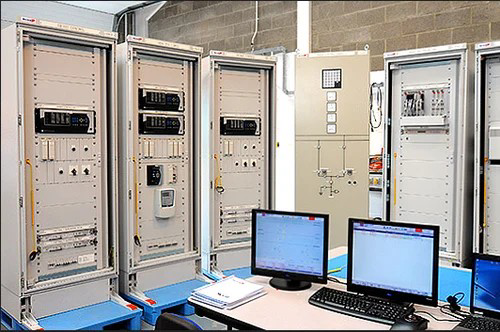POWER SYSTEM AUTOMATION
Power-system automation is the act of automatically controlling the power system via instrumentation and control devices. Substation automation refers to using data from Intelligent electronic devices (IED), control and automation capabilities within the substation, and control commands from remote users to control power-system devices.
Since full substation automation relies on substation integration, the terms are often used interchangeably. Power-system automation includes processes associated with generation and delivery of power. Monitoring and control of power delivery systems in the substation and on the pole reduce the occurrence of outages and shorten the duration of outages that do occur. The IEDs, communications protocols, and communications methods, work together as a system to perform power-system automation. The term “power system” describes the collection of devices that make up the physical systems that generate, transmit, and distribute power. The term “instrumentation and control (I&C) system” refers to the collection of devices that monitor, control, and protect the power system. Many power-system automation are monitored by SCADA.
Power-system automation is composed of several tasks.
- Data acquisition
- Data acquisition refers to acquiring, or collecting, data. This data is collected in the form of measured analog current or voltage values or the open or closed status of contact points. Acquired data can be used locally within the device collecting it, sent to another device in a substation, or sent from the substation to one or several databases for use by operators, engineers, planners, and administration.
- Supervision
- Computer processes and personnel supervise, or monitor, the conditions and status of the power system using this acquired data. Operators and engineers monitor the information remotely on computer displays and graphical wall displays or locally, at the device, on front-panel displays and laptop computers.
- Control
- Control refers to sending command messages to a device to operate the I&C and power-system devices. Traditional supervisory control and data acquisition (SCADA) systems rely on operators to supervise the system and initiate commands from an operator console on the master computer. Field personnel can also control devices using front-panel push buttons or a laptop computer.
In addition, another task is power-system integration, which is the act of communicating data to, from, or among IEDs in the I&C system and remote users. Substation integration refers to combining data from the IED's local to a substation so that there is a single point of contact in the substation for all of the I&C data.
Power-system automation processes rely on data acquisition; power-system supervision and power-system control all working together in a coordinated automatic fashion. The commands are generated automatically and then transmitted in the same fashion as operator initiated commands.
Blog Posted:
J.Jagan Rupchand. M.E.,


Comments
Post a Comment